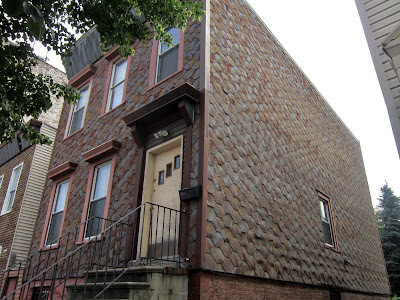Asphalt roofing & siding materials find their roots in the mid-nineteenth century.
Composition roofing materials using fabrics covered with pine tar or sand were in use on the East Coast by the 1840s. This form was later improved through coatings of asphalt and talc, sand, powdered limestone or gravel to add color and endurance. Modern roofing shingles were formed from units of felt saturated with asphalt, a bitumen produced from refined petroleum, and colored mineral or ceramic granules. Shingles cut from rolls in 8" X 12-1/2" shapes made their appearance in 1903 in rectangular and hexagonal forms. (National Register of Historic Places/Arkansas Historic Preservation Program)
By the early 1900s, manufacturers started to consider the use of roofing shingles on walls, though they were not marketed nationally for this purpose until the late 1920's. They offered the customer a less expensive, low-maintenance form of wall-covering. Though rectangular and hexagonal shingles were still produced into the 1940's, faux-brick panels seem to become the the more popular and more widely marketed asphalt covering of choice by this point in time. You'll see plenty of shingles and faux-brick in the 1940's City tax photos. Other styles developed from the 40's on included "ashlar-stone," "Ranch-Stone" (50's) & "Random Stone." (60's).

Brick-paneling, right (52nd & 58th Streets)
Random-Stone (11th, facade in decline, & now long gone, & Sixth, in fine shape, but about to go )
A great miscellany of wood-coverings on 19th
I like seeing those wooden houses still covered in their 40's brick-paneling, especially if, like the ones above, they've preserved many of the houses' original features, and I've developed a fondness, too, for the Random & awnings looks of the 50's and 60's. But those hexagonal asphalt shingles might just be my favorites. Today you'll mostly find them on the sides of a building (see above), left untouched while the front got a more recent do-over. Again on 19th:
I had a nice chat with a longtime-resident of this house. We talked about the effort involved in keeping up old wooden houses, and how sad it was to see them disappearing so fast. Don't those hexagonals look good, set next to that fine old cornice?
For a great, completely covered job, look at this house on 39th. All-hexagonal shingles, all the time! Those shingles have held up pretty damn well over sixty or seventy years.






No comments:
Post a Comment